
भाकृअनुप - केन्द्रीय कृषि अभियांत्रिकी संस्थान, भोपाल
ICAR - Central Institute of Agricultural Engineering, Bhopal

CRP on Farm Mechanisation and Precision Farming
About CRP
The main focuses of the CRP on FM and PF are to accelerate the development /adaptation of need based technology through functional networking with stakeholders (Commodity Institutes, AICRP Centres, SAU/AUs and Commodity boards); to strengthen the manufacturing activities in the field of farm mechanization through ensuring quality in manufacturing testing and standardization of farm equipment; to create and test models of farm machinery promotion through custom hiring and farm machinery resource centre; demonstration and popularization of package of equipment based on different cropping systems.
Contact Us

Dr. V P Chaudhary
PI, Principal ScientistMob. No.- 91-755-2521077
Email: vp_ch@yahoo.co.in
Partners of Project “CRP on farm Mechanization and Precision farming”
| S. No. | Name of Centre |
|---|---|
| 1. | ICAR-CIAE Regional Centre (RC), Coimbatore |
| 2. | ICAR- Central Plantation Crops Research Institute (CPCRI), Regional Centre, Guwahati |
| 3. | ICAR- Central Research Institute for Dryland Agriculture (CRIDA) Hyderabad |
| 4. | ICAR- Indian Institute of Horticultural Research(IIHR), Bengaluru |
| 5. | ICAR- Research Complex for Eastern Region Centre (RCER), Patna |
Prominent Technologies Developed
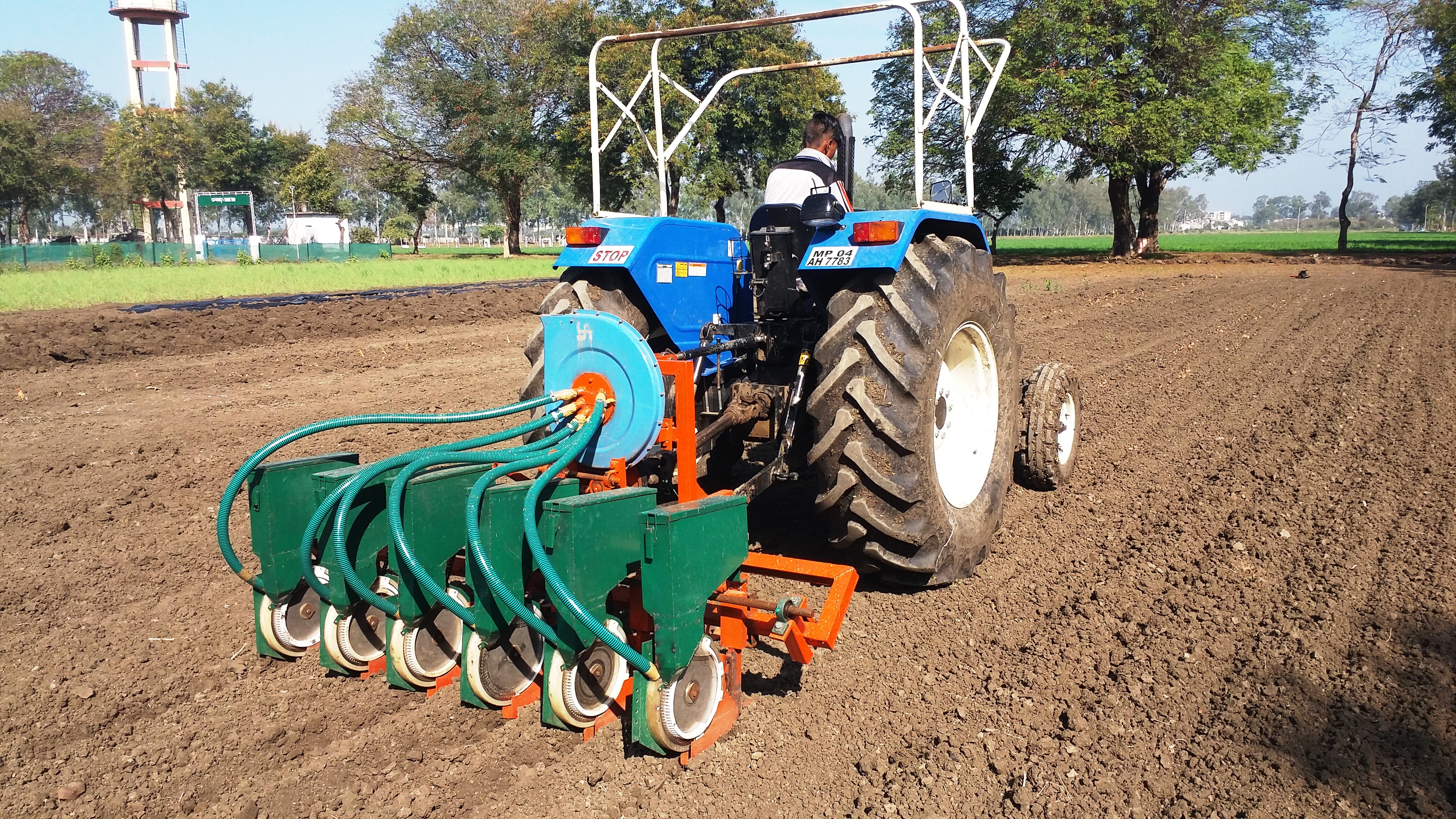
Tractor operated high speed planter for soybean
Time window available for sowing of soybean during Kharif season is very small due to onset of south-west monsoon. Therefore, efforts have been made to develop high speed planter for soybean to achieve timeliness in operation. The planting unit consists of a seed hopper of 7.0 kg capacity, metering mechanism, tine, shaft and accessories. The miss index, multiple index, quality of feed index and precision index were found to be 1.67, 14.38, 83.95, and 22.34, respectively at 7.0 km/h speed of operation and 100 mm spacing of soybean, whereas the width of operation, field capacity, field efficiency of the machine were found to be 2100 mm, 0.9 ha/h, 68%, respectively. The cost of operation is Rs. 740/h. The break-even point and payback period of the machine are 48 h and 2.9 year, respectively. It saves 64.3% of time with respect to conventional planter operated at 2.5 km/h forward speed.
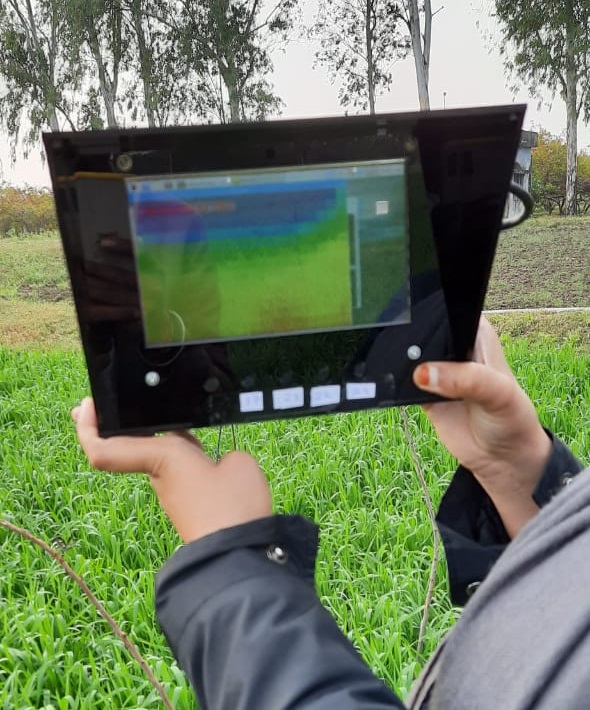
RGB-Infrared thermal imaging camera
Crop stress monitoring is an important component for real time application of irrigation to field crops. The commercially available thermal imagers are costly and have limitations in spatial and real time data collection and processing. Therefore, a RGB and infrared thermal imager (FoV:60°) has been developed. It captured thermal images of wheat crop and stored their GPS locations in Raspberry Pi board. Serial communication protocol was used for transferring of pixels to microcontroller. The RGB and temperature pixels were processed in software and pixels were plotted in the form of image. The maximum, minimum and mean temperatures in winter wheat crop at CRI stage were found to be 22, 14 and 14.75 °C, respectively. The temperature resolution was 0.25 °C and measurement accuracy was 2.5 °C. The developed imager can be utilized for crop stress monitoring and real time application of irrigation scheduling.
Tractor operated potato combine
Potato digging and bagging are tedious, drudgery prone and time consuming operations. Therefore, a tractor (50 hp) operated single-row potato combine has been developed to mechanize these operations. Soil-potato mass after digging by a V-scoop type blade passes over the soil separation unit. Haulm gets separated from the potatoes at the top most section of soil separation unit where potatoes with clods fall over counter rotating cylinders. It passes the potato clod mixture over a conveyor belt, where clods get separated and the clean potatoes are delivered into a temporary storage tank, which further transferred to gunny bags, which are passed on to ground after stitching. The field capacity and field efficiency and harvesting efficiency of the potato combine were found to be 0.16 ha/h and 93%, 94%, respectively. The total cost and operational cost of the potato combine is Rs. 750,000/- and Rs.1,270/h, respectively.
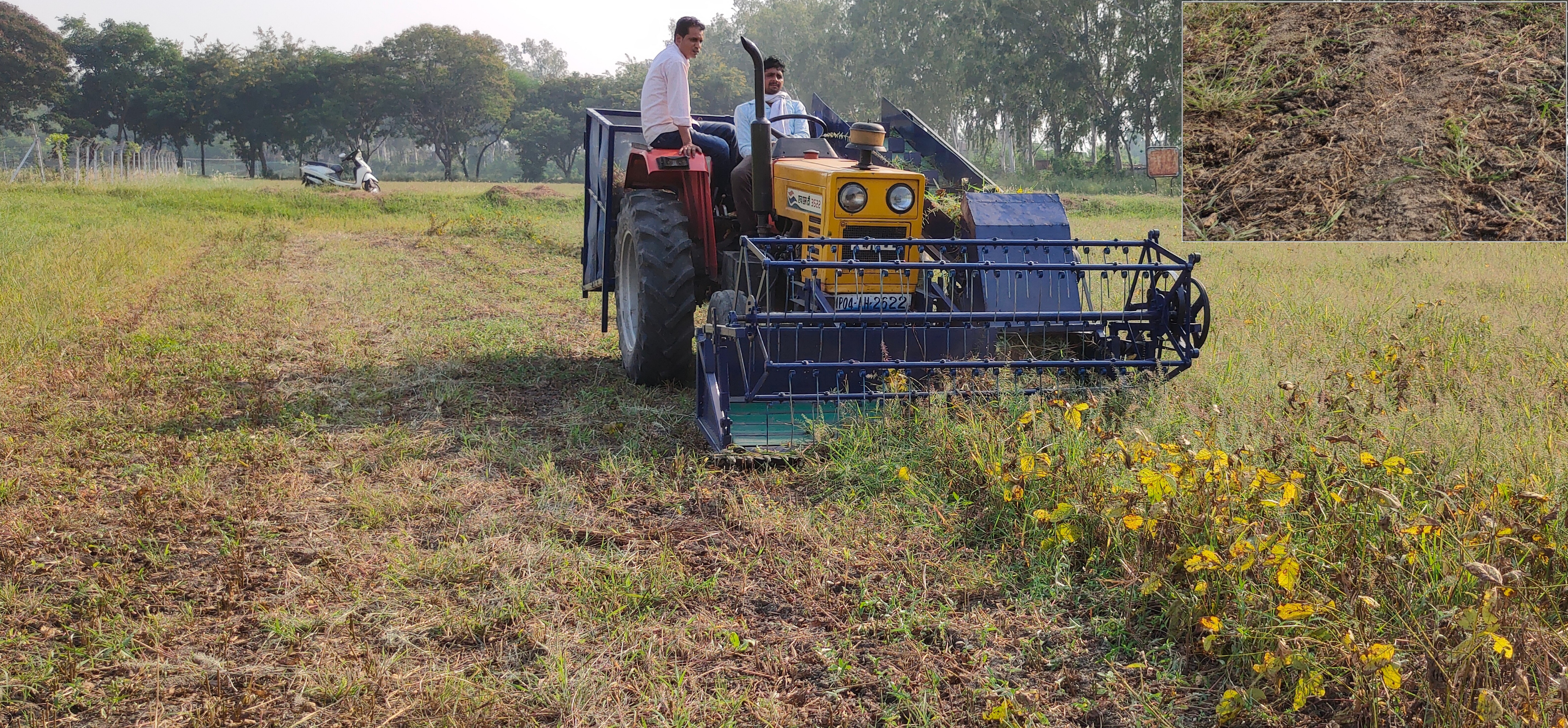
Integrated system for harvesting and conveying of bunch crops
Harvesting of bunch crops (soybean, black gram, green gram etc.) is being carried out manually in some regions of country, which requires 18-25 man-days/ha. The manually harvested crops are collected at one point and threshed. Therefore, a tractor operated integrated harvesting-cum-conveying machine has been developed. It is a modified vertical conveyor reaper with an integrated conveying system for conveying cut crop to a collection box/trailer. The average height of cut, effective field capacity and field efficiency of machine were found to be 66-80 mm, 0.25 ha/h and 78 %, respectively at 1.5 km/h forward speed. The harvesting losses were 1.5-2.9 % for soybean, black-gram and green-gram crops. The approximate cost of the machine is Rs. 100,000/- and cost of operation is Rs. 711/h. Equipment can give economic benefit and time saving of 49 and 60%, respectively in comparison to manual harvesting of bunch crops by sickle.
Residue mulcher-cum-bed planter for maize-wheat cropping system
Sowing of maize and wheat on raised bed in presence of crop residue is one of the tedious operations, which requires residue management and furrow making system along with sowing. Therefore, a zero-till residue mulcher-cum-bed planter has been developed for planting of maize and wheat on beds under zero-till conditions. After combine harvesting of previous bed sown crop, the residue is first mulched by using mulcher and planting of maize and wheat is done simultaneously using inclined plate metering device. Provision has been made to form both broad and narrow beds by using same machine. The optimal speed of planting and mulching was 3.0 and 2.7 km/h, respectively. The field capacity of this machine was varied from 0.30 to 0.45 ha/h at forward speed of 3 km/h for planting of maize and wheat. The cost of operation of equipment is Rs. 930/ha and fuel consumption is 15 L/ha.
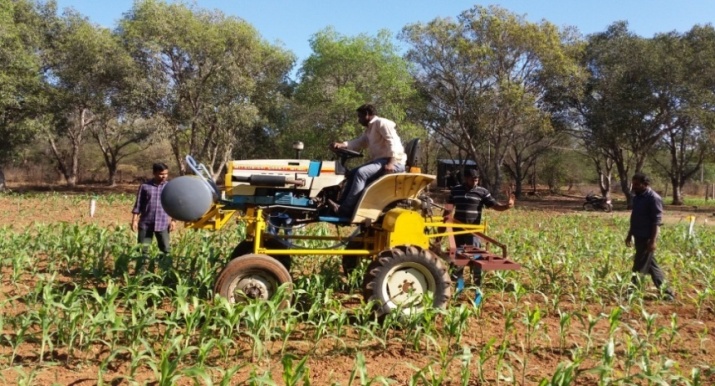
High ground clearance platform for small tractor
CAR-CRIDA, Hyderabad centre has developed a high ground clearance platform for small horse power tractor for inter row weeding and spraying operation in 2020. The tyres centre to centre distance was 165 cm and ground clearance 90 cm. The cost of the high clearance platform set up for mini tractor in the range of 18-22 hp was about Rs.55,000/-. To use the modified tractor components effectively a rotary tiller for intercultural and weeding operation and boom sprayers were also developed. To utilize the high clearance platform effectively a rotary weeder has been developed by considering the crop row spacing and other machine parameters. The weeding efficiency of rotary machine is found to be 82.5% and 86.8% for castor and pigeon pea, respectively. It is highly helpful for timely completion of field operations and drudgery reduction. The cost of the rotary weeder is about Rs.25,000/- ICAR-CRIDA, Hyderabad centre has developed a boom sprayer matching to high clearance small tractor. The field capacity of the machine ranged from 1.7 - 2.0 ha/hr. The approximate cost of the machine is Rs. 22,000/- and its operating cost is Rs 600/-per ha.
.jpg)
Motorized protray, poly bag and pot filling machine
Raising vegetable involves cleaning, mixing and filling of growing media. Therefore, a motorized growing media siever, mixer and protray filling machine has been developed by IIHR, Bangalore centre. It consists of growing media elevator, siever-cum-protray filler and mixer-cum-bag filler. The growing media gets filled in the loader of the growing media elevator. Bucket elevator lifts the growing media from the loader to the sieving unit. The bucket elevator has 1.5 – 2.0 tonne/h capacity. The growing media sieve-cum-protray filler is operated with a 2.0 HP, 3-phase, geared electrical motor. Three numbers of bag filling outlets are provided at the end of the mixer with oscillating type valve control. The capacity of the machine is around 1.5 – 2.0 tonnes/h of growing media. Almost 60% of man power can be saved per day compared to manual method. The cost of the machine is Rs. 500,000/-.
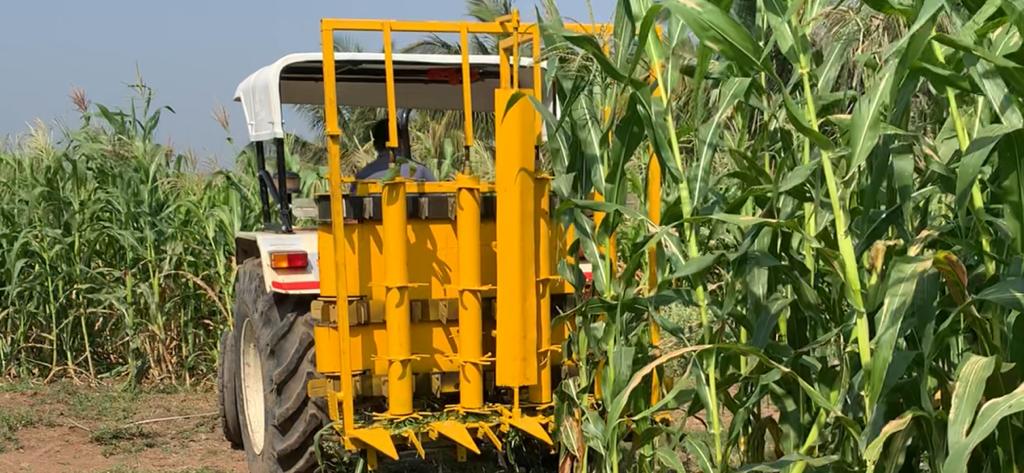
Tractor mounted harvester for maize and sorghum crops
The maize and sorghum crops are harvested manually, which is tedious and time consuming operation. Therefore, a tractor mounted harvester has been developed at ICAR-CRIDA Hyderabad, for harvesting of maize and sorghum, pearl millet and other taller and wide row crops. It is much useful for small farm holding farmers. The cutting efficiency and field capacity of equipment are 80% and 0.4 ha/hour, respectively at 1 km/h operating speed and 850 rpm rotational speed of cutting blade. The cost of machine and cost of operation is Rs.150,000/- and Rs. 1,500/- per hour, respectively. It saves 40% in cost of harvesting compared to the manual harvesting operation.






